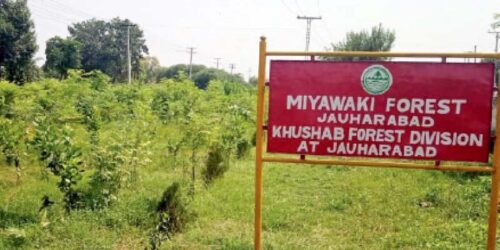Granting the status of a ‘model forest’ to the Miyawaki forest planted in Jauharabad town adjacent to Khushab, the Ministry of Climate Change (MOCC) has recommended implementation of similar projects along the motorway, in Multan city its environs.
Forest Department SDO Abdul Ghaffar told The Express Tribune that Japanese scientist Akira Miyawaki introduced the method of planting forests in urban areas in 1970.
Through the method, forests can be planted on land measuring one marla to a few acres in cities. The idea was promoted in view of the trees’ role as “the lungs of the earth”.
The method has also been adopted in Pakistan and the forest department planted the model forest on five kanals of land in Khushab district.
The official said the environment could be made cleaner and healthier with Miyawaki forests in the cities to counter the increase in greenhouses gases as well as water, air and land pollutants.
“The land is deeply excavated and various types of local nutrients and fertilisers, including nitrogen, phosphorus and potassium, are added to the soil. The ground is levelled and large trees, shrubs, herbs and grass are grown on it,” the forest department official said.
A distance is ensured between certain types of trees, while those that are compatible are planted closer together and special care is taken for nurturing them, he elaborated. “Joharabad is being presented as a model of Miyawaki forest as the original Japanese method was followed while growing it.”
The total expenditure on the forest was Rs612,000 in three years, which is very low considering its importance and usefulness, he claimed.
District Forest Officer Naseem Iqbal Butt said the Miyawaki method produces 10 times more trees in an area than in natural forests. “Forests grown in this way are much denser than the natural jungles.”
He added that urban forestry not only helps in eliminating pollution in densely populated areas but also creates beauty and makes the environment pleasant.
“In the Miyawaki forest of Joharabad, about 25 species of trees and plants have been planted, which include Sahanjana, Behera, Sukh Chain, Palkan, Sheesham, Darikh, Bacain Bottle Brush, Table Palm, Kachnar, Jaman, Pipal, Phatix, Kakar, Santha, Mulberry, Mara, Motiya, Gulab, Amaltas and Neem. Similar trees have been planted and the distance between them is based on the principles of the Miyawaki method,” he said.
“It took a lot of hard work on the part of our staff to make the Miyawaki forest of the Khushab forest department a model, as declared by the federal ministry,” he stated.
Commenting on the projects, an arborist, Arshad Nadeem Malik, said the responsibility of the Miyawaki forests had been assigned to the forest department the Parks and Horticulture Authority (PHA).
“The project has been assigned to the forest department in Khushab and the PHA in Sargodha. The forest department has the best staff for tree planting.”
He said the forest department is spending about Rs700,000 per acre on the Miyawaki scheme, which also includes the cost of its protection.
“The PHA is reportedly spending Rs2.9 million per acre on a forest being grown in contrast to the Miyawaki method. The government should hand over all the forests to the forest department.”
Abdul Rehman, a local resident, said that the Miyawaki plantation appeared to be the best method for improving the environment.





